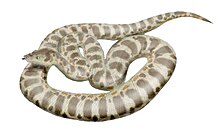Titanoboa cerrejonensis
|
Titanoboa Temporal range: Paleocene, 60–58 Ma |
|
|---|---|
 |
|
| Illustration by Nobu Tamura | |
| Scientific classification | |
| Kingdom: | Animalia |
| Phylum: | Chordata |
| Class: | Reptilia |
| Order: | Squamata |
| Suborder: | Serpentes |
| Family: | Boidae |
| Genus: |
†Titanoboa Head et al., 2009 |
| Species: | †T. cerrejonensis |
| Binomial name | |
|
Titanoboa cerrejonensis Head et al., 2009 |
|
Titanoboa, /tiˌtɑːnoʊˈboʊə/; meaning " boa," is an extinct genus of snakes that lived about 60–58 million years ago, during the Paleocene epoch, a 10-million-year period immediately following the Cretaceous-Paleogene extinction event. The only known species is Titanoboa cerrejonensis, the largest snake ever discovered, which supplanted the previous record holder, Gigantophis.
While initially thought to have been an apex predator of the Paleocene ecosystem in which it lived, evidence has pointed to the genus being dominantly piscivorous; a trait unique to Titanoboa among all boids. The size of T. cerrejonensis has also provided clues as to the earth's climate during its existence; because snakes are ectothermic, the discovery implies that the tropics, the creature's habitat, must have been warmer than previously thought, averaging about 32 °C (90 °F). The warmer climate of the Earth during the time of T. cerrejonensis allowed cold-blooded snakes to attain much larger sizes than modern snakes. Today, larger ectothermic animals are found in the tropics, where it is hottest, and smaller ones are found farther from the equator.
However, other researchers disagree with the above climate estimate. For example, a 2009 study in the journal Nature applying the mathematical model used in the above study to an ancient lizard fossil from temperate Australia predicts that lizards currently living in tropical areas should be capable of reaching 10–14 m (32.8–45.9 ft), which is obviously not the case. In another critique published in the same journal, Mark Denny, a specialist in biomechanics, noted that the snake was so large and was producing so much metabolic heat that the ambient temperature must have been four to six degrees cooler than the current estimate, or the snake would have overheated.
...
Wikipedia
